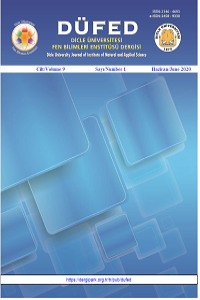Abstract
References
- Hoffmann, L. A., World Production and Use of Oats. Welch, R.W. (Ed.), The Oat Crop-Production and Utilization. Chapman and Hall, London, (1995), 34-61.
- Peterson, D. M., Wesenberg, D. M., Burrup, D. E., Erickson, C. A., Relationships Among Agronomic Traits and Grain Composition in Oat Genotypes Grown in Different Environments. Crop Sci., (2005), 45: 1249-1255.
- Corville Baltenberger, D. C., Frey, K. J., Genotypic Variability in Response of Oat to Delayed Sowing. Agron. J., (1986), 79: 813-816.
- Barut, A. A., Bazı Yulaf (Avena sativa L.) Çeşitlerinde Ekim Zamanı ve Tohum İriliğinin Verim ve Verim Öğelerine Etkisi. Ankara Ünv., Fen Bilimleri Ens. Tarla Bitkileri Anabilim Dalı, Doktora Tezi, 114s., (2003).
- Buerstmayr, H., Krenn, N., Stephan, U., Grausgruber, H., Zechner, E., Agronomic Performance and Quality of Oat (Avena sativa L.) Genotypes of Worldwide Origin Produced under Central European Growing Conditions. Field Crops Res., (2007), (101): 341351.
- Peltonen-Sainion, P., Jauhiainen, L., Laurila, I. P., Cereal Yield Trends in Northern European Conditions: Changes in Yield Potential and its Realization, Field Crops Research, (2009), 110: 85-90.
- Kün, E., Serin İklim Tahılları. Ankara Üniversitesi. Ziraat Fakültesi Yayınları, 875, Ders Kitabı, (1983), 240, s:307.
- FAO, Food and Agriculture Organization of the United Nations, (2016), http://faostat.fao.org/site/567/default.aspx#ancor. (Erişim tarihi, 26.02.2016).
- TUİK, Türkiye İstatistik Kurumu, (2016), http://www.tuik.gov.tr/PreTablo.do?alt_id=100. (Erişim tarihi, 26.02.2016).
- Choubey, R. N., Gupta, S. K., Correlation and Path Analysis in Forage Oat. Indian Journal of Agric. Science, (1986), 56(9): 674-677.
- Mut, Z., Akay, H., Köse, E., Doğanay, Ö., Grain Yield, Quality Traits and Green Yield Stability of Local Oat Cultivars. Journal of Soil Sciences and Plant Nutrition, (2018), 18 (1), 269-281.
- Katsura, M., Summer-Sown Cultivation of Forage Oats and Breeding in Japan. Jarq-Japan Agricultural Research Quarterly, (1999), 33 (1): 57-63.
- SAS Institute, SAS/STAT User’s Guide. 8 Version, SAS Inc., Cary, NC., (1999).
- Anonim, Kahramanmaraş Meteoroloji İl Müdürlüğü, (2017).
- Anonim, K.Maraş Doğu Akdeniz Geçit Kuşağı Tarımsal Araştırma Enstitüsü Müdürlüğü. Toprak-Su Kaynakları Toprak Analiz Laboratuvarı Sonuçları, (2016).
Yazlık ve Kışlık Ekilen Yulaf (Avena sativa L.) Genotiplerinin Yeşil Ot Verimi ve Silaj Kalite Özellikleri Bakımından Değerlendirilmesi
Abstract
Bu çalışmada, farklı ekim zamanlarında yetiştirilen yulaf (Avena spp.) çeşit ve hatlarının yeşil ot verimi ve silaj kalite özellikleri bakımından değerlendirilmesi amaçlanmıştır. Araştırma, Kahramanmaraş koşullarında, 2016-2017 yetiştirme sezonunda yürütülmüş, 7 yulaf hattı ile 6 tescilli yulaf çeşidi kullanılmıştır.
Araştırmada incelenen agronomik özelliklerinin hepsinin ekim zamanına (EZ) göre önemli ölçüde değiştiği belirlenmiştir. Silaj kalite özellikleri ekim zamanlarına ve genotiplere göre önemli ölçüde farklılık göstermiştir.
Keywords
References
- Hoffmann, L. A., World Production and Use of Oats. Welch, R.W. (Ed.), The Oat Crop-Production and Utilization. Chapman and Hall, London, (1995), 34-61.
- Peterson, D. M., Wesenberg, D. M., Burrup, D. E., Erickson, C. A., Relationships Among Agronomic Traits and Grain Composition in Oat Genotypes Grown in Different Environments. Crop Sci., (2005), 45: 1249-1255.
- Corville Baltenberger, D. C., Frey, K. J., Genotypic Variability in Response of Oat to Delayed Sowing. Agron. J., (1986), 79: 813-816.
- Barut, A. A., Bazı Yulaf (Avena sativa L.) Çeşitlerinde Ekim Zamanı ve Tohum İriliğinin Verim ve Verim Öğelerine Etkisi. Ankara Ünv., Fen Bilimleri Ens. Tarla Bitkileri Anabilim Dalı, Doktora Tezi, 114s., (2003).
- Buerstmayr, H., Krenn, N., Stephan, U., Grausgruber, H., Zechner, E., Agronomic Performance and Quality of Oat (Avena sativa L.) Genotypes of Worldwide Origin Produced under Central European Growing Conditions. Field Crops Res., (2007), (101): 341351.
- Peltonen-Sainion, P., Jauhiainen, L., Laurila, I. P., Cereal Yield Trends in Northern European Conditions: Changes in Yield Potential and its Realization, Field Crops Research, (2009), 110: 85-90.
- Kün, E., Serin İklim Tahılları. Ankara Üniversitesi. Ziraat Fakültesi Yayınları, 875, Ders Kitabı, (1983), 240, s:307.
- FAO, Food and Agriculture Organization of the United Nations, (2016), http://faostat.fao.org/site/567/default.aspx#ancor. (Erişim tarihi, 26.02.2016).
- TUİK, Türkiye İstatistik Kurumu, (2016), http://www.tuik.gov.tr/PreTablo.do?alt_id=100. (Erişim tarihi, 26.02.2016).
- Choubey, R. N., Gupta, S. K., Correlation and Path Analysis in Forage Oat. Indian Journal of Agric. Science, (1986), 56(9): 674-677.
- Mut, Z., Akay, H., Köse, E., Doğanay, Ö., Grain Yield, Quality Traits and Green Yield Stability of Local Oat Cultivars. Journal of Soil Sciences and Plant Nutrition, (2018), 18 (1), 269-281.
- Katsura, M., Summer-Sown Cultivation of Forage Oats and Breeding in Japan. Jarq-Japan Agricultural Research Quarterly, (1999), 33 (1): 57-63.
- SAS Institute, SAS/STAT User’s Guide. 8 Version, SAS Inc., Cary, NC., (1999).
- Anonim, Kahramanmaraş Meteoroloji İl Müdürlüğü, (2017).
- Anonim, K.Maraş Doğu Akdeniz Geçit Kuşağı Tarımsal Araştırma Enstitüsü Müdürlüğü. Toprak-Su Kaynakları Toprak Analiz Laboratuvarı Sonuçları, (2016).
Details
| Primary Language | Turkish |
|---|---|
| Subjects | Agricultural, Veterinary and Food Sciences |
| Journal Section | Research Article |
| Authors | |
| Publication Date | June 10, 2020 |
| Submission Date | April 10, 2020 |
| Published in Issue | Year 2020 Volume: 9 Issue: 1 |
Google Scholar | CABI - CAB Abstracts and Global Health | CAS Chemical Abstracts Service | ROAD Directory of Open Access Scholarly Resources | Index Copernicus | CiteFactor Academic Scientific Journals | BASE Bielefeld Academic Search Engine | Open AIRE | IJIFACTOR | ASOS Index | Paperity Open Science Aggregated | I2OR International Institute of Organized Research | SJIF Scientific Journal Impact Factor | Advanced Science Index | DRJI Directory of Research Journals Indexing | SOBİAD | AcarIndex | SIS Scientific Indexing Services | Crossref | Harman Türkiye Akademik Arşivi | AccessOn | Dimensions | Wizdom | OUCI The Open Ukrainian Citation Index | WorldCat | Scilit | ASCI Asian Science Citation Index |
 https://doi.org/10.55007/dufed.xxxxxxx
https://doi.org/10.55007/dufed.xxxxxxx




